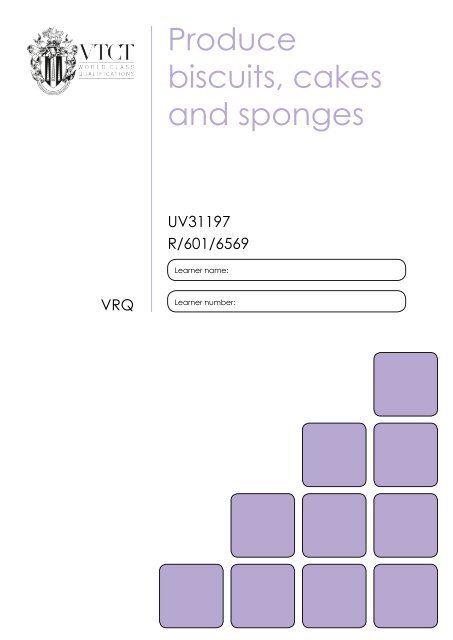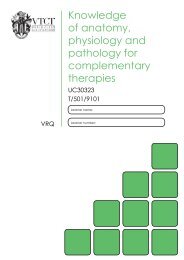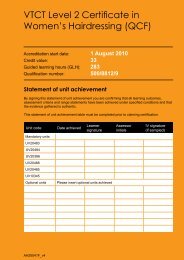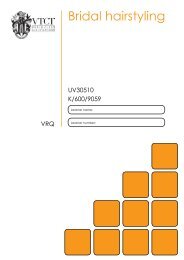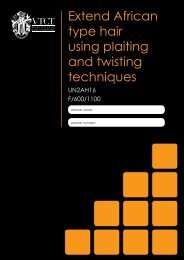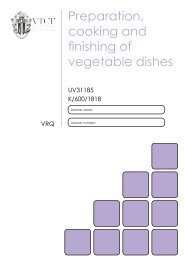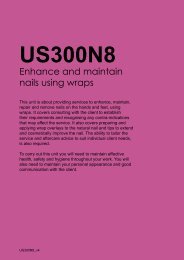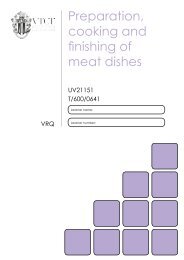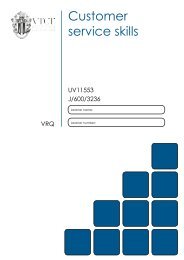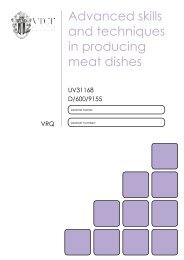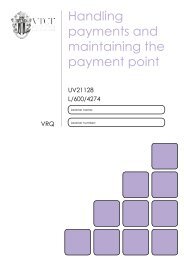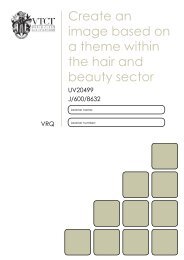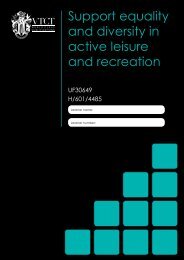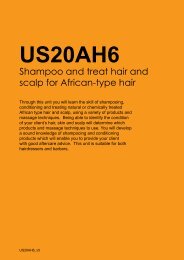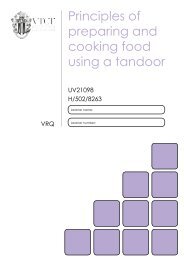Be able to produce biscuits, cakes and sponges - VTCT
Be able to produce biscuits, cakes and sponges - VTCT
Be able to produce biscuits, cakes and sponges - VTCT
You also want an ePaper? Increase the reach of your titles
YUMPU automatically turns print PDFs into web optimized ePapers that Google loves.
VRQ<br />
Produce<br />
<strong>biscuits</strong>, <strong>cakes</strong><br />
<strong>and</strong> <strong>sponges</strong><br />
UV31197<br />
R/601/6569<br />
Learner name:<br />
Learner number:
Statement of unit achievement<br />
By signing this statement of unit achievement you are confirming that all learning outcomes, assessment<br />
criteria <strong>and</strong> range statements have been achieved under specified conditions <strong>and</strong> that the evidence<br />
gathered is authentic.<br />
This statement of unit achievement t<strong>able</strong> must be completed prior <strong>to</strong> claiming certification.<br />
Unit code Date achieved Learner signature<br />
Assessor tracking t<strong>able</strong><br />
<strong>VTCT</strong> is the specialist awarding body for the Hairdressing, <strong>Be</strong>auty Therapy, Complementary Therapy,<br />
Hospitality <strong>and</strong> Catering <strong>and</strong> Sport <strong>and</strong> Active Leisure sec<strong>to</strong>rs, with over 50 years of experience.<br />
<strong>VTCT</strong> is an awarding body regulated by national organisations including Ofqual, SQA, DfES <strong>and</strong> CCEA.<br />
<strong>VTCT</strong> is a registered charity investing in education <strong>and</strong> skills but also giving <strong>to</strong> good causes in the area<br />
of facial disfigurement.<br />
Assessor name Assessor signature<br />
Assessor<br />
initials<br />
Assessors<br />
initials<br />
IV signature<br />
(if sampled)<br />
All assessors using this Record of Assessment book must complete this t<strong>able</strong>. This is required for<br />
verification purposes.<br />
Assessor number<br />
(optional)
UV31197<br />
Produce <strong>biscuits</strong>, <strong>cakes</strong> <strong>and</strong><br />
<strong>sponges</strong><br />
The aim of this unit is <strong>to</strong> develop your knowledge,<br />
underst<strong>and</strong>ing <strong>and</strong> practical skills in the production of<br />
<strong>biscuits</strong>, <strong>cakes</strong> <strong>and</strong> <strong>sponges</strong>. This unit gives you the<br />
opportunity <strong>to</strong> be innovative by developing your own<br />
recipes through research or from your own experience.<br />
You will learn how <strong>to</strong> finish products, which will involve<br />
decoration <strong>and</strong> filling techniques, in order <strong>to</strong> present<br />
<strong>biscuits</strong>, <strong>cakes</strong> or <strong>sponges</strong> in ways that are innovative<br />
but will also <strong>produce</strong> profit<strong>able</strong> results. You will also study<br />
the safe <strong>and</strong> hygienic s<strong>to</strong>rage of products that have been<br />
baked in advance.<br />
UV31197_v6
Level<br />
Credit value<br />
GLH<br />
3<br />
6<br />
49<br />
Observation(s)<br />
2<br />
External paper(s)<br />
0
Produce <strong>biscuits</strong>, <strong>cakes</strong> <strong>and</strong><br />
<strong>sponges</strong><br />
Learning outcomes<br />
On completion of this unit you will:<br />
1. <strong>Be</strong> <strong>able</strong> <strong>to</strong> <strong>produce</strong> <strong>biscuits</strong>, <strong>cakes</strong> <strong>and</strong><br />
<strong>sponges</strong><br />
2. <strong>Be</strong> <strong>able</strong> <strong>to</strong> finish <strong>biscuits</strong>, <strong>cakes</strong> <strong>and</strong><br />
<strong>sponges</strong><br />
Evidence requirements<br />
1. Environment<br />
Evidence for this unit may be gathered<br />
within the workplace or realistic working<br />
environment (RWE).<br />
2. Simulation<br />
Simulation may be used in this unit, where<br />
no naturally occurring evidence is avail<strong>able</strong>.<br />
3. Observation outcomes<br />
Competent performance of Observation<br />
outcomes must be demonstrated on<br />
at least two occasions. Assessor<br />
observations, witness testimonies <strong>and</strong><br />
products of work are likely <strong>to</strong> be the most<br />
appropriate sources of performance<br />
evidence. Professional discussion may be<br />
used as supplementary evidence for those<br />
criteria that do not naturally occur.<br />
Assessed observations should not be<br />
carried out on the same day for the<br />
same learning outcome. There should be<br />
sufficient time between assessments for<br />
reflection <strong>and</strong> personal development.<br />
You need <strong>to</strong> meet the same st<strong>and</strong>ard on a<br />
regular <strong>and</strong> consistent basis. Separating<br />
the assessments by a period of at least two<br />
weeks is recommended as competence<br />
must be demonstrated on a consistent <strong>and</strong><br />
regular basis.<br />
4. Range<br />
All ranges must be practically demonstrated<br />
or other forms of evidence <strong>produce</strong>d <strong>to</strong><br />
show they have been covered.<br />
5. Knowledge outcomes<br />
There must be evidence that you possess<br />
all the knowledge <strong>and</strong> underst<strong>and</strong>ing<br />
listed in the Knowledge section of this<br />
unit. In most cases this can be done<br />
by professional discussion <strong>and</strong>/or oral<br />
questioning. Other methods, such as<br />
projects, assignments <strong>and</strong>/or reflective<br />
accounts may also be used.<br />
6. Tu<strong>to</strong>r/Assessor guidance<br />
You will be guided by your tu<strong>to</strong>r/assessor<br />
on how <strong>to</strong> achieve learning outcomes <strong>and</strong><br />
cover ranges in this unit. All outcomes <strong>and</strong><br />
ranges must be achieved.<br />
7. External paper<br />
There is no external paper requirement for<br />
this unit.<br />
UV31197<br />
3
4<br />
Achieving observations<br />
<strong>and</strong> range<br />
Achieving observation outcomes Achieving range<br />
Your assessor will observe your performance<br />
of practical tasks. The minimum number of<br />
competent observations required is indicated in<br />
the Evidence requirements section of this unit.<br />
Criteria may not always naturally occur during<br />
a practical observation. In such instances you<br />
will be asked questions <strong>to</strong> demonstrate your<br />
competence in this area. Your assessor will<br />
document the criteria that have been achieved<br />
through professional discussion <strong>and</strong>/or oral<br />
questioning. This evidence will be recorded<br />
by your assessor in written form or by other<br />
appropriate means.<br />
Your assessor will sign off a learning outcome<br />
when all criteria have been competently<br />
achieved.<br />
UV31197<br />
The range section indicates what must<br />
be covered. Ranges should be practically<br />
demonstrated as part of an observation. Where<br />
this is not possible other forms of evidence may<br />
be <strong>produce</strong>d. All ranges must be covered.<br />
Your assessor will document the portfolio<br />
reference once a range has been competently<br />
achieved.
Learning outcome 1<br />
You can:<br />
a. Perform operations in line with current<br />
professional practices<br />
b. Produce <strong>biscuits</strong>, <strong>cakes</strong> <strong>and</strong> <strong>sponges</strong> <strong>to</strong><br />
recipe specifications:<br />
• using construction techniques<br />
• using traditional, classical <strong>and</strong> modern<br />
skills <strong>and</strong> techniques<br />
• using culinary science<br />
• using contemporary styles<br />
c. Carry out quality checks during production<br />
of <strong>biscuits</strong>, <strong>cakes</strong> <strong>and</strong> <strong>sponges</strong><br />
d. Correct products that do not meet quality<br />
requirements<br />
Observations<br />
<strong>Be</strong> <strong>able</strong> <strong>to</strong> <strong>produce</strong> <strong>biscuits</strong>, <strong>cakes</strong> <strong>and</strong> <strong>sponges</strong><br />
*May be assessed by supplementary evidence.<br />
Observation 1 2 Optional Optional<br />
Criteria questioned orally<br />
Date achieved<br />
Portfolio reference<br />
Learner signature<br />
Assessor initials<br />
UV31197<br />
5
6<br />
Learning outcome 2<br />
<strong>Be</strong> <strong>able</strong> <strong>to</strong> finish <strong>biscuits</strong>, <strong>cakes</strong> <strong>and</strong> <strong>sponges</strong><br />
You can:<br />
a. Finish <strong>biscuits</strong>, <strong>cakes</strong> <strong>and</strong> <strong>sponges</strong>:<br />
• using construction techniques<br />
• using traditional, classical <strong>and</strong> modern<br />
skills <strong>and</strong> techniques<br />
• using culinary science<br />
• using contemporary styles<br />
b. Check the finished product meets dish<br />
requirements<br />
c. Present products <strong>to</strong> meet styles of service<br />
d. S<strong>to</strong>re <strong>biscuits</strong>, <strong>cakes</strong> <strong>and</strong> <strong>sponges</strong> correctly<br />
*May be assessed by supplementary evidence.<br />
Observation 1 2 Optional Optional<br />
Criteria questioned orally<br />
Date achieved<br />
Portfolio reference<br />
Learner signature<br />
Assessor initials<br />
UV31197
You must practically demonstrate that you have:<br />
Range<br />
Used a minimum of 3 recipe techniques Portfolio reference<br />
Construction<br />
Traditional<br />
Classical<br />
Modern<br />
Culinary science<br />
Carried out quality checks on all products Portfolio reference<br />
Correct weight for number of products needed<br />
Texture of uncooked products<br />
Texture of cooked products<br />
Products cooked correctly<br />
Used a minimum of 2 finishing methods Portfolio reference<br />
Construction techniques<br />
Traditional, classical <strong>and</strong> modern skills <strong>and</strong> techniques<br />
Culinary science<br />
Contemporary styles<br />
It is strongly recommended that all range items are practically demonstrated. Where this is not<br />
possible, other forms of evidence may be <strong>produce</strong>d <strong>to</strong> demonstrate competence.<br />
UV31197 7
8<br />
You must practically demonstrate that you have:<br />
Used a minimum of 8 finishing products Portfolio reference<br />
Buttercream<br />
Pastry cream<br />
Whipped cream<br />
Jams<br />
Chocolate<br />
Fondant<br />
Royal icing<br />
Meringue<br />
Fresh fruit<br />
Ganache<br />
Chibouste<br />
Mousseline<br />
Diplomat<br />
Praline<br />
Bavarois/mousse<br />
Lemon curd<br />
Checked products meet all dish requirements Portfolio reference<br />
Colour<br />
Texture<br />
Aroma<br />
Decoration<br />
It is strongly recommended that all range items are practically demonstrated. Where this is not<br />
possible, other forms of evidence may be <strong>produce</strong>d <strong>to</strong> demonstrate competence.<br />
UV31197
You must practically demonstrate that you have:<br />
Presented products for all styles of service Portfolio reference<br />
Individual plated portion<br />
Portioned at the t<strong>able</strong><br />
Used a minimum of 2 s<strong>to</strong>rage methods Portfolio reference<br />
Airtight container<br />
Refrigeration<br />
Freezing<br />
It is strongly recommended that all range items are practically demonstrated. Where this is not<br />
possible, other forms of evidence may be <strong>produce</strong>d <strong>to</strong> demonstrate competence.<br />
UV31197 9
10<br />
Developing knowledge<br />
Achieving knowledge outcomes<br />
You will be guided by your tu<strong>to</strong>r <strong>and</strong> assessor<br />
on the evidence that needs <strong>to</strong> be <strong>produce</strong>d.<br />
Your knowledge <strong>and</strong> underst<strong>and</strong>ing will be<br />
assessed using the assessment methods listed<br />
below*:<br />
• Projects<br />
• Observed work<br />
• Witness statements<br />
• Audio-visual media<br />
• Evidence of prior learning or attainment<br />
• Written questions<br />
• Oral questions<br />
• Assignments<br />
• Case studies<br />
• Professional discussion<br />
Where applic<strong>able</strong> your assessor will integrate<br />
knowledge outcomes in<strong>to</strong> practical observations<br />
through professional discussion <strong>and</strong>/or oral<br />
questioning.<br />
When a criterion has been orally questioned<br />
<strong>and</strong> achieved, your assessor will record this<br />
evidence in written form or by other appropriate<br />
means. There is no need for you <strong>to</strong> <strong>produce</strong><br />
additional evidence as this criterion has already<br />
been achieved.<br />
Some knowledge <strong>and</strong> underst<strong>and</strong>ing outcomes<br />
may require you <strong>to</strong> show that you know <strong>and</strong><br />
underst<strong>and</strong> how <strong>to</strong> do something. If you have<br />
practical evidence from your own work that<br />
meets knowledge criteria, then there is no<br />
requirement for you <strong>to</strong> be questioned again on<br />
the same <strong>to</strong>pic.<br />
*This is not an exhaustive list.<br />
UV31197
Knowledge<br />
Learning outcome 1<br />
<strong>Be</strong> <strong>able</strong> <strong>to</strong> <strong>produce</strong> <strong>biscuits</strong>, <strong>cakes</strong> <strong>and</strong> <strong>sponges</strong><br />
You can: Portfolio reference<br />
e. Identify potential faults for a range of <strong>biscuits</strong>, <strong>cakes</strong> <strong>and</strong> <strong>sponges</strong><br />
f. Explain techniques for the production of <strong>biscuits</strong>, <strong>cakes</strong> <strong>and</strong><br />
<strong>sponges</strong>, including:<br />
• construction<br />
• traditional, classical <strong>and</strong> modern skills <strong>and</strong> techniques<br />
• culinary science<br />
• contemporary styles<br />
g. List appropriate flavour combinations<br />
h. Explain considerations when balancing ingredients in recipes for<br />
<strong>biscuits</strong>, <strong>cakes</strong> <strong>and</strong> <strong>sponges</strong><br />
i. Explain the effect of preparation <strong>and</strong> cooking methods on the end<br />
product<br />
j. Describe how <strong>to</strong> control time, temperature <strong>and</strong> environment <strong>to</strong><br />
achieve desired outcome when producing <strong>biscuits</strong>, <strong>cakes</strong> <strong>and</strong><br />
<strong>sponges</strong><br />
UV31197 11
12<br />
Learning outcome 2<br />
<strong>Be</strong> <strong>able</strong> <strong>to</strong> finish <strong>biscuits</strong>, <strong>cakes</strong> <strong>and</strong> <strong>sponges</strong><br />
You can: Portfolio reference<br />
e. Identify relevant fillings, glazes, creams <strong>and</strong> icings for <strong>biscuits</strong>,<br />
<strong>cakes</strong> <strong>and</strong> <strong>sponges</strong><br />
f. Identify ingredients in <strong>biscuits</strong>, <strong>cakes</strong> <strong>and</strong> <strong>sponges</strong> that may cause<br />
allergic reactions<br />
g. Calculate food costs for producing <strong>biscuits</strong>, <strong>cakes</strong> <strong>and</strong> <strong>sponges</strong><br />
h. Explain how food costs <strong>and</strong> other fac<strong>to</strong>rs affect profit when<br />
producing <strong>biscuits</strong>, <strong>cakes</strong> <strong>and</strong> <strong>sponges</strong><br />
UV31197
Unit content<br />
This section provides guidance on the recommended knowledge <strong>and</strong> skills required <strong>to</strong> en<strong>able</strong> you<br />
<strong>to</strong> achieve each of the learning outcomes in this unit. Your tu<strong>to</strong>r/assessor will ensure you have the<br />
opportunity <strong>to</strong> cover all of the unit content.<br />
Outcome 1: <strong>Be</strong> <strong>able</strong> <strong>to</strong> <strong>produce</strong> <strong>biscuits</strong>, <strong>cakes</strong> <strong>and</strong> <strong>sponges</strong><br />
Current professional practices: Personal<br />
hygiene, hygienic <strong>and</strong> safe techniques,<br />
hygienic <strong>and</strong> safe use of <strong>to</strong>ols <strong>and</strong><br />
equipment.<br />
Recipe specifications: Construction<br />
techniques (sugar batter, flour batter,<br />
blending), traditional (Christmas cake,<br />
simnel cake), classical (Vic<strong>to</strong>ria sponge,<br />
Dundee cake), modern techniques<br />
(muffins, cup<strong>cakes</strong>), culinary science<br />
(panary aeration, chemical aeration,<br />
lamination), contemporary styles (individual<br />
portion, Eastern/Indian ingredients).<br />
Biscuits, <strong>cakes</strong> <strong>and</strong> <strong>sponges</strong>: Varieties of<br />
tuiles (coconut, almond, dentelles, au grué<br />
de cacao), s<strong>able</strong>, Viennese, japonaise,<br />
joconde, Dutch <strong>biscuits</strong>, Madeira, sacher<br />
sponge, fruit cake (Dundee), pain de<br />
gênes, lemon cake, parkin, Swiss roll,<br />
genoise, financiers.<br />
Checks: Ingredients (colour, aroma,<br />
texture, weight), cooking temperature,<br />
cooking time.<br />
Correct products: Cover <strong>cakes</strong> during<br />
cooking, cool <strong>cakes</strong> in their tins.<br />
Faults: Overcooked (dark brown colour,<br />
hard texture), undercooked (pale<br />
colour, poor crumb), cooked <strong>to</strong>o quickly<br />
(undercooked in the middle).<br />
Techniques: Construction techniques<br />
(sugar batter, flour batter, blending),<br />
traditional, classical <strong>and</strong> modern<br />
techniques (sifting, mixing, rolling, rubbing,<br />
creaming, whipping, piping, blending,<br />
whisking, boiling), culinary science (adding<br />
yeast, adding bicarbonate of soda,<br />
laminating with fat), contemporary styles<br />
(individual portion, adding Eastern/Indian<br />
ingredients).<br />
Flavour combinations: Vanilla, chocolate,<br />
coffee, almond, dried fruit, fruit jams,<br />
walnut, lemon, orange, banana, ginger,<br />
spices.<br />
Considerations: Plasticity of fat used, fats<br />
add moisture, eggs provide structure <strong>and</strong><br />
appearance, dried fruits absorb flavours.<br />
Effects: Sifting (removes lumps), mixing<br />
(blends ingredients), rolling (defines<br />
shape), rubbing (<strong>produce</strong>s a rougher<br />
blend), creaming (adds air while mixing),<br />
whipping (aerates), piping (final shape of<br />
the product), blending (mixing ingredients),<br />
whisking (aeration), boiling (infuses flavour<br />
in<strong>to</strong> fruit).<br />
Control time, temperature <strong>and</strong><br />
environment: Set oven timer, preheat<br />
oven <strong>to</strong> desired temperature, avoid opening<br />
the oven during cooking, sufficient lighting.<br />
UV31197 13
14<br />
Outcome 2: <strong>Be</strong> <strong>able</strong> <strong>to</strong> finish <strong>biscuits</strong>, <strong>cakes</strong> <strong>and</strong> <strong>sponges</strong><br />
Finishing: Construction techniques<br />
(decoration, tiers), traditional <strong>and</strong> classical<br />
(as defined in recipes), modern techniques<br />
(alternative flavours/ingredients in<br />
finishing), culinary science (decoration will<br />
not adversely affect product), contemporary<br />
styles (modern appearance).<br />
Dish requirements: Colour, texture,<br />
aroma, decoration.<br />
Presentation: Self-service (individual<br />
portion), t<strong>able</strong> service (individual portion,<br />
portioned at the t<strong>able</strong>).<br />
Correct s<strong>to</strong>rage: Airtight container,<br />
refrigeration, freezing, labelled, dated, useby<br />
date.<br />
Fillings, glazes, creams <strong>and</strong> icings:<br />
Buttercream, pastry cream, whipped<br />
cream, jams, chocolate, fondant, ganache,<br />
royal icing, meringue, fresh fruit, chibouste,<br />
mousseline, diplomat, praline, bavarois/<br />
mousse, lemon curd.<br />
Allergic reactions: Wheat products, milk<br />
products, eggs, seeds, nuts, gelatine.<br />
Food costs: Purchase price of ingredients.<br />
How food costs <strong>and</strong> other fac<strong>to</strong>rs<br />
affect profit: Food costs, staffing costs,<br />
overheads (power, lighting, equipment, rent<br />
<strong>and</strong> rates), net profit, gross profit, selling<br />
price.<br />
UV31197


